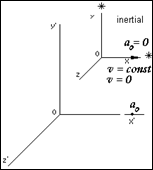
CATEGORIES:
BiologyChemistryConstructionCultureEcologyEconomyElectronicsFinanceGeographyHistoryInformaticsLawMathematicsMechanicsMedicineOtherPedagogyPhilosophyPhysicsPolicyPsychologySociologySportTourism
Lecture 7. Forces of Inertia
Newton’s Laws are correct only if the coordinate system does not accelerate. The coordinate systems that are at rest or are moving rectilinearly and uniformly are called inertial systems. The inertial systems are connected with so-called “fixed” far stars. The coordinate systems which are moving with acceleration are called noninertial. In an inertial system  or
or  and
and  .
.

Figure 7.1
For a body
 . (
. (  ) (7.1)
) (7.1)
Strictly speaking the coordinate that is connected with the Earth is not inertial. In a noninertial system we should add acceleration of body and acceleration of the coordinate system:
 =>
=> 
 =>
=>  ;
;  (7.2)
(7.2)
The product -  is called force of inertia:
is called force of inertia:

 (7.3)
(7.3)
The force caused by an acceleration of the coordinate system is called the force of inertia. Its magnitude is equal to a product of the body’s mass by the coordinate system acceleration.
Force of inertia is directed in the opposite direction to acceleration. The force  can be also called the inertial resistance. The force of inertia has got the following peculiarities and differences:
can be also called the inertial resistance. The force of inertia has got the following peculiarities and differences:
1) There are no interactions of bodies.
2) It changes as a result of a transition to other coordinate system.
3) It doesn’t obey the Third Newton’s Law.
4) The forces of inertia exist only from the point of view of an observer which is located in the noninertial system.
Let us consider an example. A body lies on a cart. Cart starts the motion and moves with acceleration  . An observer existing in the noninertial coordinate system
. An observer existing in the noninertial coordinate system  says: ”The cart started motion and it resulted in acting force is directed oppositely to the cart acceleration.” But other observer in motionless system
says: ”The cart started motion and it resulted in acting force is directed oppositely to the cart acceleration.” But other observer in motionless system  says: ”Nothing of that kind! The card went away and the body simply stayed at its place”. Who is right?
says: ”Nothing of that kind! The card went away and the body simply stayed at its place”. Who is right?

Figure 7.2
Date: 2015-01-12; view: 1438
| <== previous page | | | next page ==> |
| Fundamental equation of motion for a rotating body | | | Lecture 8. Vibrations |